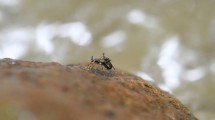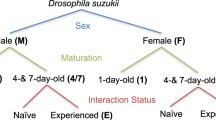Abstract
The courtship behaviors and cuticular hydrocarbons ofDrosophila rajasekari are described. Sexually mature males orient, tap, follow, vibrate their abdomens, extend and vibrate their wings, and attempt copulation during courtship. They perform these behaviors in response to immature and matureD. rajasekari of both sexes, and their courtship activities are facilitated by light. The predominant cuticular hydrocarbon found in both sexes is (Z,Z)-7,11-heptacosadiene (HCD), a compound known to be used as a courtship-stimulating sex pheromone by another fruit fly,D. melanogaster. Therefore, it is not surprising thatD. melanogaster males actively court both males and females from theD. rajasekari stock. However, HCD is apparently not used byD. rajasekari as a courtship-stimulating pheromone since matureD. rajasekari males do not courtD. melanogaster females, which produce large quantities of HCD.
Similar content being viewed by others
References
Antony, C., andJallon, J.-M. 1982. The chemical basis for sex recognition inDrosophila melanogaster.J. Insect Physiol. 28:873–880.
Antony, C., Davis, T.L., Carlson, D.A., Pechine, J.-M., andJallon, J.-M. 1985. Compared behavioral responses of maleDrosophila melanogaster (Canton-S) to natural and synthetic aphrodisiacs.J. Chem. Ecol. 11:1617–1629.
Bartelt, R.J., andJackson, L.L. 1986. Cuticular hydrocarbons ofDrosophila virilis: Comparison by age and sex.Insect Biochem. 16:433–439.
Bartelt, R.J., Armold, M.T., Schaner, A.M., andJackson, L.L. 1986a. Comparative analysis of cuticular hydrocarbons in theDrosophila virilis species group.Comp. Biochem. Physiol. 83B:731–742.
Bartelt, R.J., Moats, M.L., andJackson, L.L. 1986b. Relationships between structure and Chromatographic retention forn-alkadienes.J. Chromat. 366:27–37.
Blomquist, G.J., Nelson, D.R., andde Renobales, M. 1987. Chemistry, biochemistry, and physiology of insect cuticular lipids.Arch. Insect Biochem. Physiol. 6:227–265.
Curcillo, P.G., andTompkins, L. 1987. The ontogeny of sex appeal inDrosophila melanogaster males.Behav. Genet. 17:81–86.
Jallon, J.-M., andHotta, Y. 1979. Genetic and behavioral studies ofDrosophila female sex appeal.Behav. Genet. 9:257–275.
McEwen, R.S. 1918. The reaction to light and gravity inDrosophila and its mutants.J. Exp. Zool. 25:49–106.
McRobert, S.P., andTompkins, L. 1983. Courtship of young males is ubiquitous inDrosophila melanogaster.Behav. Genet. 13:517–523.
McRobert, S.P., andTompkins, L. 1987. The effect of light on the sexual behavior ofDrosophila affinis.Behav. Neural. Biol. 47:151–157.
Nichols, P.D., Guckert, J.B., andWhite, D.C. 1986. Determination of monounsaturated fatty acid double-bond position and geometry for microbial monocultures and complex consortia by capillary GC-MS of their dimethyl disulfide adducts.J. Microbial. Methods 5:49–55.
Scott, D. 1986. Sexual mimicry regulates the attractiveness of matedDrosophila melanogaster females.Proc. Natl. Acad. Sci. U.S.A. 83:8429–8433.
Sreerama Reddy, G., andKrishna Murty, N.B. 1968.Drosophila rajasekari—a new species from Mysore (India).Proc. Indian Acad. Sci. 68B:202–205.
Sturtevant, A. 1915. Experiments on sex recognition and the problem of sexual selection inDrosophila.J. Anim. Behav. 5:351–366.
Tompkins, L. 1984. Genetic analysis of sex appeal inDrosophila.Behav. Genet. 14:411–440.
Tompkins, L., Hall, J.C., andHall, L. 1980. Courtship-stimulating volatile compounds from normal and mutantDrosophila.J. Insect Physiol. 26:689–697.
Vincenti, M., Guglielmetti, G., Cassani, G., andTonini, C. 1987. Determination of double bond position in diunsaturated compounds by mass spectrometry of dimethyl disulfide derivatives.Anal. Chem. 59:694–699.
Author information
Authors and Affiliations
Rights and permissions
About this article
Cite this article
McRobert, S.P., Jackson, L.L. Description of sexual behaviors ofDrosophila rajasekari . J Chem Ecol 15, 1423–1432 (1989). https://doi.org/10.1007/BF01012374
Received:
Accepted:
Issue Date:
DOI: https://doi.org/10.1007/BF01012374




